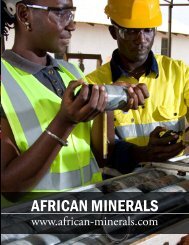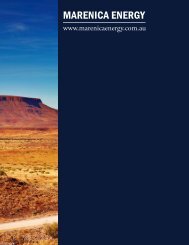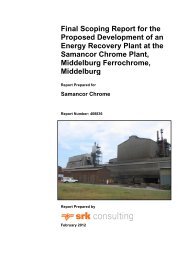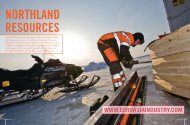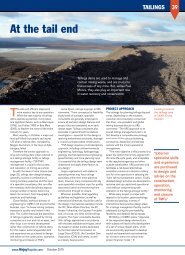Draft Status Quo Report for the Pixley Ka Seme ... - SRK Consulting
Draft Status Quo Report for the Pixley Ka Seme ... - SRK Consulting
Draft Status Quo Report for the Pixley Ka Seme ... - SRK Consulting
Create successful ePaper yourself
Turn your PDF publications into a flip-book with our unique Google optimized e-Paper software.
<strong>SRK</strong> <strong>Consulting</strong> in association with BKS<br />
<strong>Pixley</strong> <strong>Ka</strong> <strong>Seme</strong> Local Municipality EMF – <strong>Draft</strong> <strong>Status</strong> <strong>Quo</strong> <strong>Report</strong> Page 28<br />
Map 18 and Map 19). Map 20 provides an overview of<br />
<strong>the</strong> aquatic biodiversity of PKSLM.<br />
Table 3-2: PES categories<br />
Category Description Rating System used <strong>for</strong> Wetlands<br />
A<br />
B<br />
C<br />
Unmodified, natural<br />
Largely natural, with<br />
few Modifications<br />
Moderately Modified<br />
Not within 100 m of any of <strong>the</strong><br />
above land use types<br />
Within 100 m of both urban areas<br />
and mines<br />
Within 100 m of ei<strong>the</strong>r cultivated<br />
areas or degraded areas<br />
The most important environmental factors that<br />
influence <strong>the</strong> distribution of <strong>the</strong> plant communities are<br />
terrain morphology and soil wetness. The vegetation<br />
types are depicted in Table 3-3 and Map 22.<br />
Table 3-3: Vegetation types<br />
Specialist classification Mucina and Ru<strong>the</strong>r<strong>for</strong>d (2006)<br />
Western Plains Grassland<br />
Central Plains Grassland<br />
Soweto Highveld Grassland<br />
Frank<strong>for</strong>t Highveld Grassland<br />
Amersfoort Highveld Clay<br />
Grassland<br />
D<br />
Largely Modified<br />
Within 100 m of urban areas, mines<br />
and commercial plantations<br />
Wakkerstroom Plains<br />
Grassland<br />
Wakkerstroom Montane<br />
Grassland<br />
E Extensively Modified<br />
F Critically Modified<br />
Source: DWAF (1999)<br />
Eastern Plains Grassland<br />
Escarpment Grassland<br />
Mountain Grassland<br />
Eastern Highveld Grassland<br />
Paulpietersburg Moist Grassland<br />
Low Escarpment Moist Grassland<br />
Wakkerstroom Montane<br />
Grassland<br />
3.2.8 Terrestrial ecology<br />
Bredenkamp (2010) provides an overview of <strong>the</strong><br />
Terrestrial Ecology of <strong>the</strong> PKSLM. Terrestrial<br />
biodiversity is represented in Map 21.<br />
Habitat loss, degradation and fragmentation in <strong>the</strong><br />
Mpumalanga Province have placed floral and faunal<br />
species under severe pressure. Factors that have<br />
contributed to this include (Mpumalanga SOER, 2003):<br />
• Agricultural development and inappropriate<br />
practices;<br />
• Commercial af<strong>for</strong>estation;<br />
• Human overpopulation;<br />
• Neglect of conservation of grasslands and wetlands;<br />
• Alien vegetation;<br />
• Overgrazing;<br />
• Inappropriate burning regimes; and<br />
• Modification of aquatic ecosystems e.g. rivers and<br />
wetlands.<br />
Areas within <strong>the</strong> PKSLM that are rated as Protected or<br />
Irreplaceable <strong>for</strong> terrestrial ecosystem are <strong>the</strong> high lying<br />
areas on <strong>the</strong> eastern side of <strong>the</strong> study area, including <strong>the</strong><br />
Paardeplaats Nature Reserve, Wakkerstroom vlei,<br />
<strong>Ka</strong>strol Nek and surrounding areas.<br />
Flora<br />
Forest<br />
Wetlands<br />
Western Plains Grassland<br />
Nor<strong>the</strong>rn Afromontane Forest<br />
Eastern Temperate Freshwater<br />
Wetlands<br />
This vegetation type is restricted to <strong>the</strong> western portion<br />
of <strong>the</strong> PKSLM, and is largely trans<strong>for</strong>med (25%). Large<br />
areas are already developed <strong>for</strong> agricultural purposes,<br />
which has led to <strong>the</strong> destruction of vast tracts of this<br />
grassland. Western Plains Grassland is extremely<br />
poorly conserved, with none of <strong>the</strong> vegetation type<br />
currently statutorily protected, though a small part is<br />
protected in <strong>the</strong> Bloukop and Reitvaal Conservancies<br />
situated within <strong>the</strong> PKSLM. This grassland is<br />
endangered mainly due to agriculture.<br />
Central Plains Grassland<br />
This type of grassland covers a large part of <strong>the</strong> study<br />
area (41%), and 27% is trans<strong>for</strong>med, mainly by<br />
agriculture. This is also poorly conserved with a small<br />
part protected within <strong>the</strong> area of <strong>the</strong> Reitvaal<br />
Conservancy and partly in <strong>the</strong> proposed Baltrasna<br />
Conservency in <strong>the</strong> PKSLM.<br />
Wakkerstroom Plains Grassland<br />
This grassland community occurs in <strong>the</strong> north-eastern<br />
parts of <strong>the</strong> study area, and is likewise trans<strong>for</strong>med by<br />
agriculture, comprising 17% of <strong>the</strong> area. The proposed<br />
KILI/BEAT G:\404946_PIXLEY EMF\7REPORTS\<strong>Status</strong> <strong>Quo</strong> report\<strong>Draft</strong> report\<strong>Draft</strong> status quo report, July 2010.docx July 2010




